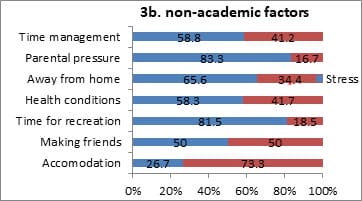Evaluation of stress parameters in new medical entrants based on their admission criteria to a south Indian medical college
Manju C.1, Alexander R.2*, Divakaran B.3
DOI: https://doi.org/10.17511/ijmrr.2019.i04.04
1 Manju C., Assistant Professor, Department of Physiology, Army College of Medical Sciences, , Delhi, India.
2* Reena Alexander, Associate Professor, Department of Physiology, Sree Narayana Institute of Medical Sciences, Ernakulum, Kerala, India.
3 Binoo Divakaran, Assistant Professor, Biostatistics, Department of Community Medicine, Academy of Medical Sciences, Kannur, Kerala, India.
Objectives: Globally medical education is now recognized as a highly stressful course and students that enter this program are subject to multiple stress producing factors that affect their academic performance as well as their mental and physical well being. This study was done to determine the prevalence of stress among first year medical (MBBS) students based on their admission criteria and to identify the sources of stress among them. Material and method: A Cross sectional study. The study was conducted in a semi-government medical college, Kerala, India. Subjects included first year medical students (both male and female) enrolled in the college during the year of study. Interventions: GHQ-12 Questionnaire was used to assess the psychological stress. A pretested structured closed ended questionnaire to collect information regarding the academic and non-academic sources of stress was charted out. Result: A total of 100 students were admitted to the first year of which 85 consented to take part in this study. Of the 85 students, 42 (49.4%) were having stress. Of these, 35 (83.3%) were repeaters (attempted the medical entrance examination more than once) and among them, 26 (61.9%) were students who secured admission based on merit. A statistically significant association was seen between the number of attempts, admission criteria and stress (p<0.05). Conclusions: This study found that stress was more among repeaters and those who secured admission based purely on merit. Nonresident Indian (NRI) students who secured admission through higher financial investments along with sudden displacement from home environment also suffered from significant stress levels. The possible sources of stress found in the study can be a preliminary step towards developing solutions for stress management and stress prevention in new medical entrants which could help in developing a new generation of stress free doctors capable of effectively providing high quality medical care to the community at large.
Keywords: Repeaters, Medical students, Stressors
| Corresponding Author | How to Cite this Article | To Browse |
|---|---|---|
| , Associate Professor, Department of Physiology, Sree Narayana Institute of Medical Sciences, Ernakulum, Kerala, India. Email: |
Manju C, Alexander R, Divakaran B. Evaluation of stress parameters in new medical entrants based on their admission criteria to a south Indian medical college. Int J Med Res Rev. 2019;7(4):273-279. Available From https://ijmrr.medresearch.in/index.php/ijmrr/article/view/1069 |


 ©
© 




